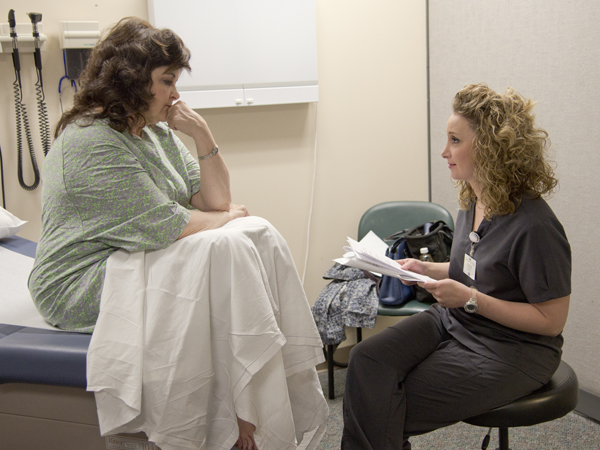Behavioral health gets interprofessional at clinical skills assessment center

Published in News Stories on May 12, 2016
“How many glasses of wine do I drink?” asked J. Doe number one.
“It says three to four,” said J. Doe number two.
“That seems like a lot. Is that per day or per week?” asked number one.
“Per day,” replied J. Doe number three.
“Are we going to be gowned for this?” asked J. Doe number four.
“Yes, you will wear gowns,” answered Paula Rutledge, program administrator at the Judith Gore Gearhart Clinical Skills Assessment Center located at the Jackson Medical Mall. “Today's exercise will include occupational therapy students. They will be wearing scrubs. When you get to the evaluation, know that scrubs are okay and should not count against them for appearance.”
The eight J. Does have gathered in a conference room to discuss the game plan for the morning's exercise. They are standardized patients, specialized actors trained to portray clinical cases and provide learner feedback. (The case name has been changed so as not to reveal the identity to future health-care providers, because it is one of about 50 scripts recycled each semester at the center.)

The actresses meet with Paula Rutledge, right, program administrator at the Clinical Skills Assessment Lab at the Jackson Medical Mall, before assuming the persona of the standardized patient, Jane Doe, for the students.
The standardized patients were instructed by the script to create dark circles under their eyes with makeup and to arrive with a disheveled hairdo and unkempt appearance.
This preparation is a routine occurrence in the assessment center. Standardized patients have assisted in medical student training for years. What's different about this day is that the students participating are not a group of future M.D.s. Included in this exercise are students from the Schools of Nursing and Health Related Professions.

Young
“This is our first real interprofessional activity where the learners from different disciplines are consulting and collaborating with each other, focusing on teamwork,” said Dr. Kathleen Young, newly appointed director of the center who completed a postdoctoral fellowship in primary care psychology in the UMMC Department of Family Medicine in 2013. “In general, health care has become more interprofessionally-oriented. To be able to provide effective health care, we have to work with people in other professions. Hopefully, exercises like this will make the students more comfortable working with people outside of their own profession.”
The activity is the second for participants in the nursing school's Integrated Behavioral Health Program. The students were first tested with standardized patients last fall. This particular exercise includes seven psychiatric nurse practitioner students paired with nine occupational therapy students.
The program is funded by a $2.1 million grant from the Health Resources and Services Administration's Advanced Nursing Education grant program. Project directors for the grant are Dr. Janet Harris, professor and associate dean for practice and community engagement and director of the doctor of nursing practice program, and Dr. Robin Christian, associate professor of nursing.

The nurse practitioner students take 10 minutes to discuss the patient case with their OT student partners. From left are students Aubrey Collins, Laura Johnson, Daniel Holloway, Jayla Anthony, John Kirkpatrick and Caroline Campbell.
Harris said that she and her colleagues “now understand, even more than before, the importance of collaborative efforts in this area.”
“We have discovered that the different disciplines really do not understand the work of the others,” said Harris. “So we have found it beneficial to start by talking about 'roles' together in a group.”
The role-play exercise at the clinical skills center is really a clinical assessment. Each segment is timed, and the students turn in notes by paper or electronically. They are also given feedback by the patient actors on their professional appearance, friendliness, eye contact, and other interpersonal skills necessary for successful provider-patient interaction.
In this activity, each nurse practitioner student begins by spending 25 minutes with their own version of Ms. Doe. She tells the student that she's been feeling tired and hasn't been sleeping well. Next comes a 10 minute briefing between the nurse practitioner and the occupational therapy students. After the consultation, it is time for the occupational therapy student to visit the patient.

OT2 Devin Hart, right, gives her patient practical advice on ways she can cope with anxiety.
Jane Doe, the one played by Dr. Brenda Sumrall Smith, retired UMMC director of social work, said that the interdisciplinary model is helpful because different people learn in different ways.
“It provides a second chance to communicate and a different way for the patient to click with the health-care provider,” said Smith. “One provider may explain something in a way that the patient doesn't understand.
“The nurse practitioner was more focused on diagnosis, finding a medical cause for my lack of sleep. The occupational therapist was more focused on giving me some things that I could do, myself, to deal with the insomnia and anxiety.”
Laporshia McBeth, a master's student in the psychiatric/mental health nurse practitioner program, said that interdisciplinary activities, such as the exercise she and occupational therapy student Devin Hart took part in, can save a patient repeated visits for the same complaints.
“The collaboration of the occupational therapist and the nurse practitioner working together eliminates the time a patient spends before diagnosis and treatment,” said McBeth. “The patient leaves one visit with a clearer understanding.”
Having both the clinical diagnosis and self-help strategies can give the patient more control over their own health.
“I think it makes the patient feel more taken care of,” said Hart. “They leave the clinic with an actual plan for getting better.”


